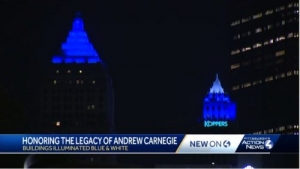Downtown Pittsburgh’s building lights commemorated centennial anniversary of his death

Two Pittsburgh downtown buildings lit up in blue and white Aug. 11, 2019, to mark the legacy of Andrew Carnegie, who died 100 years earlier on Aug. 11, 1919.
Carnegie called Pittsburgh his home for a quarter of his life and its steel mills are where he made the majority of his wealth – totaling $401.5 billion in today’s dollars –and where he invested much of it back into the community.
Pittsburgh’s Koppers Building and Gulf Tower were illuminated in blue and white –the colors of the flag of Carnegie’s home country, Scotland – as a nod to Carnegie’s omnipresent influence in Pittsburgh.
Worldwide, 22 Carnegie institutions – in international peace, education, arts, science, culture, and philanthropy – have spent more than 100 years continuing the work set forth by Carnegie.
Four of those organizations are in Pittsburgh: the Carnegie Hero Fund Commission, Carnegie Library of Pittsburgh, Carnegie Mellon University, and Carnegie Museums of Pittsburgh.
That’s the largest concentration of Carnegie organizations worldwide, which is unsurprising as Carnegie himself said Pittsburgh entered his heart as a boy and “cannot be torn out.”
Last year, the four Pittsburgh institutions partnered in hosting an event that celebrated Carnegie’s philanthropic legacy to the city, as part of “Forging the Future,” a year-long series of events held across the globe commemorating Carnegie’s lasting achievements in international peace, education, the arts, science, culture, and philanthropy, which culminated in the commemoration of his centennial death anniversary.
“In celebrating the legacy of Andrew Carnegie, our founder, we celebrate his incredibly thoughtful, forward-looking gift to a city that, at the time, was known entirely for its grit, not its culture,” said Bill Hunt, chair of the Carnegie Museums board of trustees. “His museums have always been places where everyone is invited to explore worlds, past and present, through the lens of art and science. He was passionate about what the simple act of walking through a gallery of paintings or a hall of dinosaurs could trigger in a visitor, especially young visitors. And the impact of his gift certainly still resonates today in the million-plus people who visit his Pittsburgh museums each year.”
Dr. Farnam Jahanian, president of Carnegie Mellon University, spoke of Carnegie’s impact on education locally and across the globe. “There is no better example of the power of an individual to make a difference than the life and legacy of Andrew Carnegie,” he said. “As the president of the university that bears his name here in Pittsburgh, I am reminded of Andrew Carnegie’s impact on education every day.”
Today, Carnegie Mellon University includes nearly 14,600 students in more than 26 degree programs in 14 countries around the world. Carnegie emigrated from Scotland at the age of 12 and went straight to work as a bobbin boy in Pittsburgh. On Saturdays, Col. James Anderson would invite working boys to his home to select a book to borrow and read that week.
“Mr. Carnegie credited this reading for his success, as he went on to become the richest man in the world,” said Mary Frances Cooper, president & director of Carnegie Library of Pittsburgh. “One hundred years after his passing, we still look to him as an example of an immigrant who came to this country, worked hard, achieved astounding wealth, and gave back.”
Carnegie funded the construction of 2,509 Carnegie libraries from Malaysia to Australia.
“He coined the idea that knowledge should be “free to the people,’ and, with access to books and reading and self-directed learning, a person could be anything he or she wants to be. Andrew Carnegie’s true legacy is how his particular brand of philanthropy reflects a fundamental faith in people and in our individual and collective desire to do the right thing,” Cooper said.
Toward the later years of his life, Carnegie became a fierce proponent of peace, and attempted to foster worldwide military disarmament, the end of the arms race, and compulsory arbitration (instead of war) for disputing countries.
At home, he championed a shift of society’s attention from glorying military heroes to honoring civilian heroes.
At another Carnegie event held Sept. 24, 2019, at the Peace Palace in The Hague, historian David Nasaw talked at length about Carnegie’s campaign for peace.
“‘Most of the monuments in this world,’ Carnegie had discovered were ‘to somebody who has killed a lot of his fellowmen.’ That was not heroism. His Hero Fund would call attention to, recognize, and reward the true heroes of this world,” Nasaw explained quoting Carnegie.
At the Pittsburgh event, Hero Fund President Eric Zahren expounded on this, Carnegie’s reasons for starting the Fund, and the reasons Carnegie’s legacy and the Hero Fund continue to be relevant today.
It is important to remember why the work of honoring heroes transcends geography and time and becomes relevant to all civilization, he said.
“And that is hope. The hope that is born, despite the realities of the challenges of the world – Carnegie’s and our own – through the glorious meeting of courage and ultimate respect for another human being. Hate, violence, intolerance, war itself cannot, by definition, exist in such an environment of universal individual selflessness,” Zahren said.
On the occasion of Carnegie’s death anniversary Zahren added, “Carnegie stands alone, unrivaled, as the all-time greatest individual contributor to the city of Pittsburgh.”
The Koppers Building houses the Carnegie Hero Fund. The flag of Scotland is a white X-shaped cross, or “Saltine” that represents the patron saint of Scotland, Saint Andrew, on a blue background.
Related articles:
- Nothing yet.

